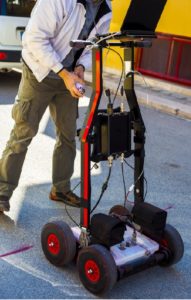
In the field of utility locating, there are many different tools that people use to try and locate subsurface objects. One such tool is called ground-penetrating radar (GPR). GPR is a useful tool for many situations, but you should always know precisely which situations are best for using it. Here is what ground-penetrating radar does, and when it is best to use it for your next construction project.
What is Ground Penetrating Radar?
GPR uses radar pulses to find objects that are buried beneath the surface of the ground. It’s a handy tool in utility locating because ground penetrating radar is non-destructive, meaning it won’t cause any harm to the worksite or any nearby buildings. It’s used in many different fields, including archaeology and geology. Even those in the military use GPR so they can find landmines and underground passages.
When Should You Use Ground Penetrating Radar?
Talking about what GPR is can be an easy task. However, it can be hard to determine when it’s best to use it. In a broad sense, it is used for utility locating, and while it can often be the perfect tool for many tasks, it does come with its limitations.
Ground-penetrating radar doesn’t work on all surfaces. For example, heavy clay-based soils don’t serve as the best foundation for GPR because of how conductive the surface becomes. Rocky soil is also not the ideal surface for GPR because radar signals can scatter as a result of the rocky surface. Speak with a utility locating company if you aren’t sure if you should use GPR on your worksite. Experts will know all of the limitations of GPR and be able to determine if it’s the ideal tool to use.
Is Ground Penetrating Radar the Tool to Use For My Next Project?
GPR is a handy tool that can make underground utility locating much easier and safer. While it isn’t a universal option, it’s useful for many different construction sites. We advise you to speak with a professional to determine if GPR is best to use on your project. Every client has different circumstances, and it takes someone who is familiar with many different settings to understand what tools are best for your job.
Concrete Visions Will Get The Job Done Right
Concrete Visions has been working with clients for over 25 years. Our G&M Services installers are certified with the industry’s major firestop product manufacturers. As part of our firestop service, we can assess abnormal field conditions and, with the manufacturer’s technical support assistance, provide engineering judgments in a timely fashion to comply with contract specifications. Our Field Mechanics undergo ongoing training, including mandatory monthly safety meetings, weekly Toolbox Talks where safety and equipment information is shred, and trainings on safe work standards and safety best practices.
